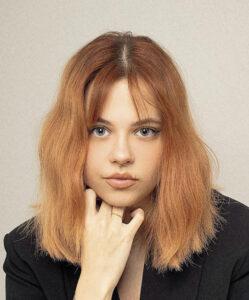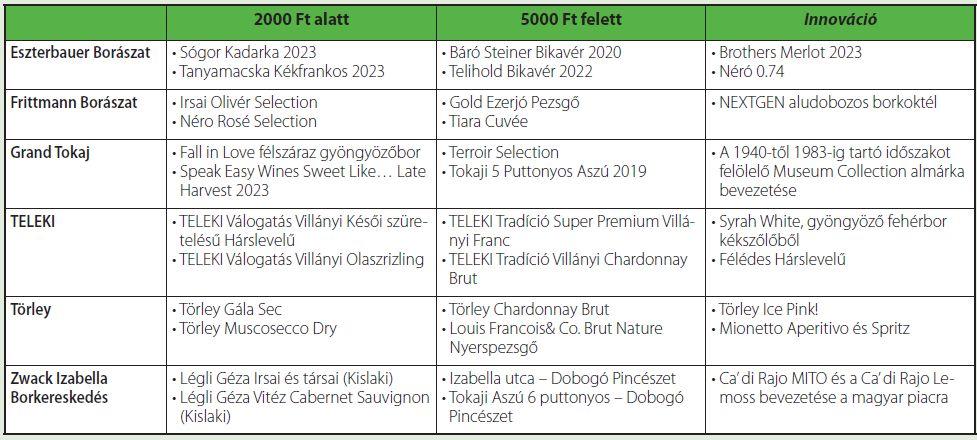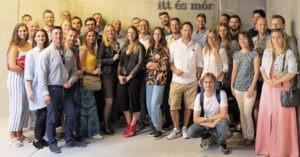Leaving the negative period behind
According to the data by IWSR, 2.57 million hectolitres of wine and 150,000 hectolitres of champagne and sparkling wine were sold in retail in 2023, representing a decline of 1.8% and 7.4%, respectively, from the 2022 level. However, experts are optimistic about the next five years, with annual sales growth of the two types of beverage forecast to average 0.3% and 1.7%, respectively, until 2028.
This article is available for reading in Trade magazin 2024/11

Barbara Pap-Szőnyi
brand manager
Csányi Winery
“As a result of this year’s extremely warm weather, our wines have become richer in flavour. Climate change isn’t new to viticulture; our winery has been preparing for new challenges for almost a decade. We have also planted grape varieties that prefer warmer climates, such as Petit Verdot and Malbec”,
explains Barbara Pap-Szőnyi, brand manager of Csányi Winery.
In July the company launched the revamped TELEKI brand.
Climate change can be prepared for

János Eszterbauer
owner
Eszterbauer Winery
“In the Szekszárd wine region 70-75% of the grapes grown are blue, as we make red wines. The warming and extreme precipitation patterns associated with climate change haven’t caused significant problems, and to a certain extent they even increased quality. Warming can be partly beneficial for blue grapes”,
says János Eszterbauer, owner of Eszterbauer Winery.

János Frittmann
co-owner
Frittmann Winery
János Frittmann, co-owner of Frittmann Winery:
“In 2024 the grape harvest was a medium one in terms of quantity. The quality is very good, with some varieties having higher alcohol content than usual. Fortunately the fruity wines that we produce are becoming more and more popular. We can work quite well with the retail chains”.

Gergely Kovács
marketing manager
Grand Tokaj
“The 2024 grape harvest was truly exceptional. Climate challenges and the issue of global warming require strategic reorientation not only in Tokaj, but in the entire wine and grape sector. Based on the experience of recent years, it will be key role to retain the water from the rare but often heavy rainfall in our vineyards and to protect the soil by planting cover crops”,
says Gergely Kovács, marketing manager of Grand Tokaj.

Looking ahead to the next half-decade, experts are optimistic and forecast a CAGR of 0.3 per cent in wine and 1.7 per cent in sparkling wine until 2028
More good wines, fewer buyers

Zalán Szittnyai
wine expert
Zwack Izabella
Borkereskedés
Zalán Szittnyai, wine expert of Zwack Izabella Wines:
“The winners of the warming will be Mediterranean grape varieties and Cabernet will certainly be good too, while the loser could be Pinot Noir. As Zwack Izabella Wines is primarily a supplier of HoReCa partners, our sales depend on the situation in the hospitality sector. This spring didn’t bring the expected sales increase, but we hope that the last few months of the year will be stronger”.
Barbara Pap-Szőnyi underlines that in recent years they have had outstanding results in the discount supermarket channel. This is mainly the result of successful private label partnerships, the optimal price-value ratio of their wines and partner-specific product innovation. In HoReCa they couldn’t grow, but with the relaunch of the TELEKI brand they seek to reactivate this channel.
János Eszterbauer believes the decline in wine consumption is related to healthy lifestyle and a general anti-alcohol consumption sentiment.

The problems in the hospitality sector are also felt heavily by winemakers
Closer to the consumer
János Frittmann informs that they are targeting all age groups. The winery is beginning to understand that young, new wine drinkers can be introduced to the taste of wine with wine-based drinks in 250ml size. Their NEXTGEN aluminium can packaged wine cocktail is in line with the latest trends. He thinks the main reason for the decline in wine consumption in Hungary is the zero tolerance policy.
Gergely Kovács reports that their cooperation with most retail chains is working well. A good example of this is the partnership with Lidl, which is 20 years old this year: they are really satisfied with the cooperation in both the domestic and international markets, for private label (Amethyst) and Grand Tokaj wines alike.
Zalán Szittnyai opines that retail chains are clearly price-focused. In the HoReCa channel price is also important but quality, being special and having a story are just as important. Zwack tries to meet the needs of both channels. Wine has more and more competitors. With the rise of the bar culture, people are more and more interested in colourful drinks, but also in classic long drinks and cocktails. //
Say 33!
This year’s Budapest Wine Festival took place in September – for the 33rd time – once again on the terrace of the Budavár Palace.

The guest of honour was Georgia, not only with wines but also with Georgian culture and gastronomy. Festival visitors could test their senses and wine knowledge in the VinAgora Interactive Wine Tent. The VinAgora International Wine Competition was held with the slogan “Central Europe’s wine compass”, while at the VinAgora Discoveries stand wine lovers had the chance to discover rare treasures, typically from lesser-known but very exciting wineries. //
Commitment
Hungary is committed to the preservation of its viticultural and oenological heritage, said István Nagy, Minister of Agriculture at a conference in Dijon in October, which marked the 100th anniversary of the founding of the International Organisation of Vine and Wine (OIV). Hungary is proud to have been one of the 8 countries that founded the organisation in Paris 100 years ago. Hungary wishes to continue working together, at a global level but based on Hungarian traditions and expertise. //
Wines you should try!
We asked the wine experts which products they would recommend to our readers in the below HUF 2,000 and over HUF 5,000 categories, and to name their recent innovations.

//
Representing the interests of young winemakers

Zsolt Tiffán
president
Junibor
Zsolt Tiffán, president of Junibor introduces the association:
“Junibor – Young Winemakers Association was founded in 2008, with the goal of creating a community for the professional development of the next generation of winemakers. The most important thing for us is to help each other to make better wines that consumers love. We also place great emphasis on reaching out to young wine drinkers.
Junibor has 49 members in 2024 and it is open to young winemakers under the age of 35, who are committed to quality wine production and who make their own wines in a family-owned winery. Once a year we host tasting events, where aspirants can introduce themselves. Membership applications can be sent to info@junibor.hu”. //

The Junibor association is a community of 50 winemakers under 35 years of age, helping each other and creating a community committed to quality winemaking
//

Kornél Müller
managing director
Törley Pezsgőpincészet
Sparkling wine 2024
Over the past year and a half the sparkling wine market has been declining in volume and growing in value, with increasing demand for higher value products. The prosecco category has shown definite growth. Thanks to our wide range of products, we can target a variety of consumer groups. In the domestic market there is still a considerable share of sweet sparkling wines, but a dynamic shift towards dry sparkling wines can be observed. We are always looking to innovate and are constantly monitoring international market trends. It is clear that demand for non-alcoholic beverages has increased a lot. Our Non-alcoholic Törley White and Rosé are still very popular with consumers, and the Törley portfolio also includes Freixenet 0.0 and Mionetto Non-alcoholic. //
Households are buying less wine


Guest writer:
Zsombor Ecsedi
data analyst
Consumer Panel Services
YouGov
In the 12 months leading up to August 2024, consumers bought significantly less wine (almost 10% less in volume) than in the same period a year earlier. Among alcoholic beverages the drop in volume sales was the biggest here. 60% of Hungarian households purchase wine at least once a year, with an average buying frequency of 13 times over the 12- month period, which was a 6% decrease compared to August 2023 MAT. Apart from wines, only sparkling wines suffered a sales drop in the alcoholic beverages category. As for price, wine has seen a surge of 14% compared to the other alcoholic drink categories. One litre now costs HUF 1,100 on average. Over the past 12 months the average household bought just over 20 litres of wine, which translates into a 12-month spend between HUF 22,000-23,000.
Dry wine is the most popular, with 40% of Hungarian households buying it, and it also accounts for nearly half of volume sales. It is followed by sweet wine (which reaches a third of households) and semi-sweet wine (which reaches a quarter of households). Red wine is the most popular, having almost half of the market in both value and volume. White wine is the second most popular, with almost 40% of the market, followed by rosé at 15%. In terms of size 750ml wines have the largest share in the category, with three quarters of value sales and just over half of volume sales. Higher quality wines are the most popular among households, representing two thirds of the market and consumers spending on average HUF 1,800 per occasion on such wines. Almost half of households are buying wine in discount supermarkets. //
Related news
Lidl and the Ministry of Agriculture announced: the domestic melon season has begun
The first shipment of watermelons from Hungarian suppliers has arrived…
Read more >Producers and consumers must be brought closer together
By strengthening the short supply chain, producers and consumers must…
Read more >Imre Hubai: Hungarian wine is an unparalleled national treasure
Hungarian wine is a unique national treasure that the entire…
Read more >Related news
GKI analysis: Why do Hungarian households live more poorly than anyone else in the EU?
Imagine that the residents of every EU country shop in…
Read more >KSH: industrial producer prices decreased by 0.7 percent in May 2025 compared to the previous month, and increased by an average of 6.9 percent compared to a year earlier
In May 2025, industrial producer prices were 6.9 percent higher…
Read more >Consumption drives the economy
According to the latest forecast by the Balance Institute, the…
Read more >






